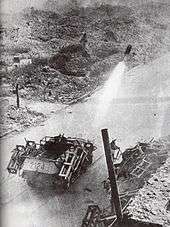Wurfrahmen 40


The Wurfrahmen 40 ("launch frame 40") was a German World War II multiple rocket launcher. It combined a vehicle such as the SdKfz 251 halftrack or captured ex-French Renault UE Chenillette with rocket artillery to form a more mobile and protected artillery piece than the towed Nebelwerfer. It was nicknamed Stuka zu Fuss ("Stuka on Foot" or "Walking Stuka") and Heulende Kuh ("Bellowing Cow").[1] Introduced in late 1940, the weapon system was a framework with adjustable base plates fitted over and alongside a vehicle which could hold 300 mm high explosive (HE) rockets; 280 mm HE and 320 mm incendiary rockets were also used, the rockets being fired while in their loading crates. Although spin stabilized, the rockets were not as accurate as conventional artillery and reloading was time consuming due to the rocket's weight. Rockets were ripple-fired in large numbers where feasible to quickly saturate a target. The Wurfrahmen 40 was successful in service as a support weapon for the mobile Panzer formations, particularly in urban areas.
When used on the common mounting, the Sd.Kfz. 251 halftrack, a frame with six base plates were used, with three on each side. The Chenillette UE employed either two per side or four frames on the rear. The Hotchkiss H35 mounting used two per side also. Some captured American M3 halftracks also mounted Wurfrahmen, with four frames at two per side.[2]
See also
- Nebelwerfer
- Panzerwerfer
- American T40 Whizbang
References
External links
![]() Media related to Wurfrahmen 40 at Wikimedia Commons
Media related to Wurfrahmen 40 at Wikimedia Commons